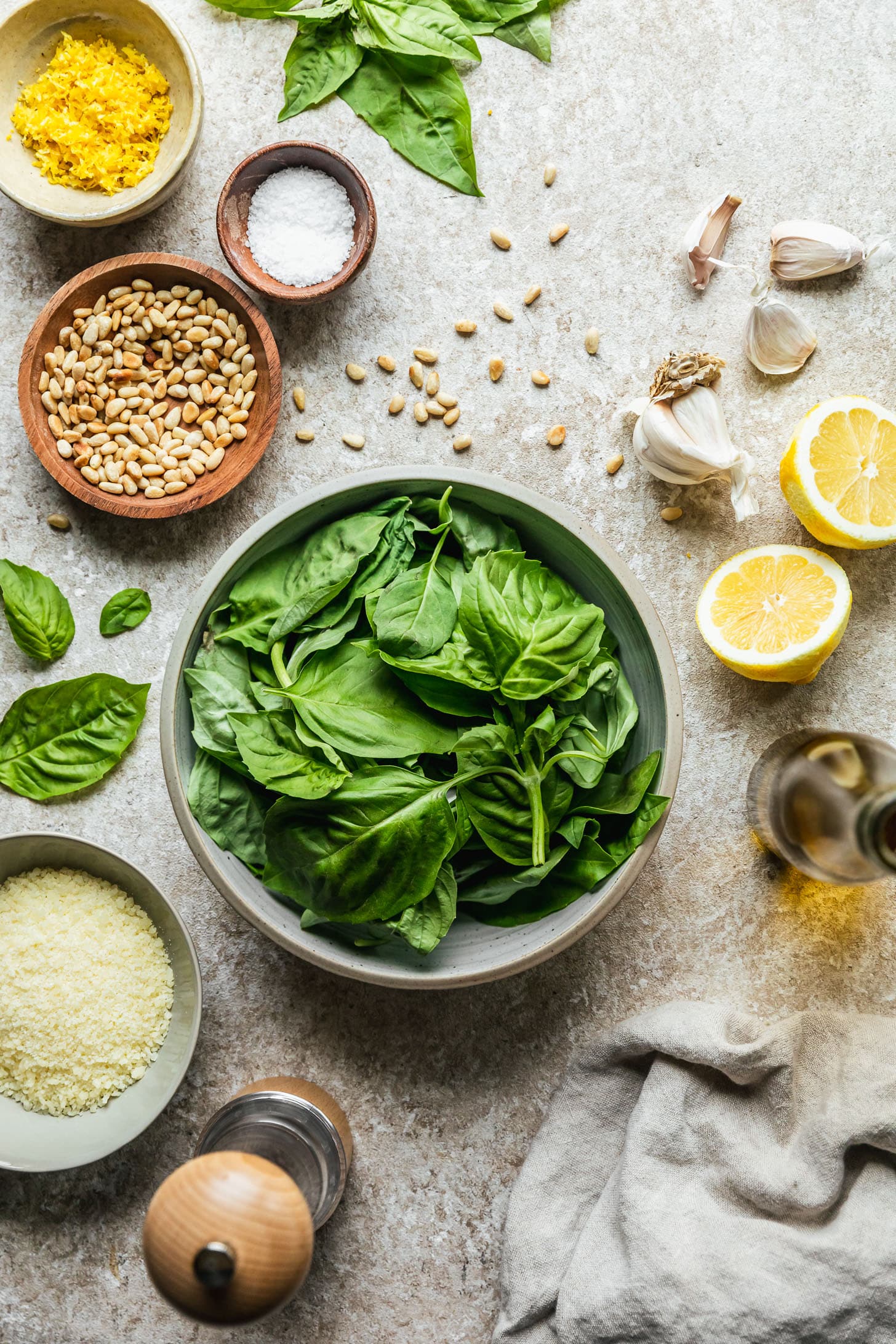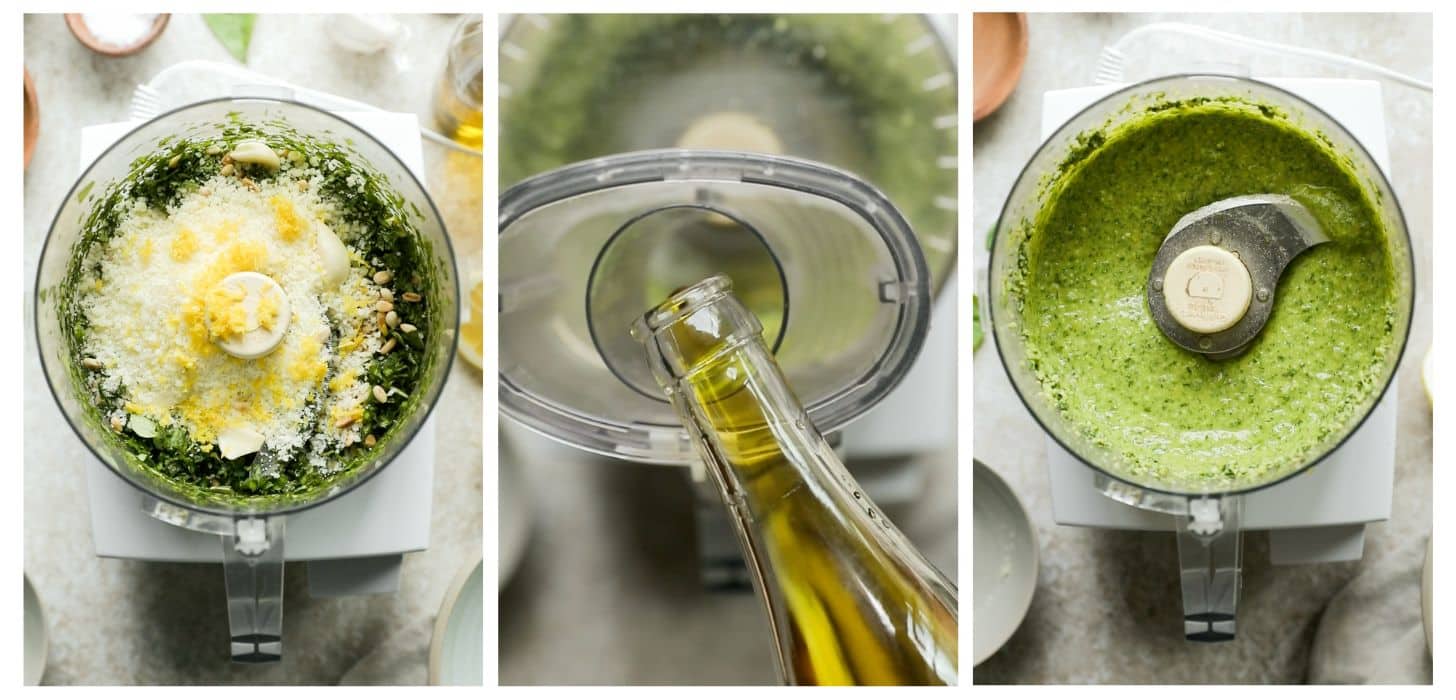Lemon Pesto with Basil
This post might have affiliate links. For full details please see my disclosure policy.
I could truly put this lemon pesto on just about everything. It’s inspired by classic Italian pesto but it has a lovely citrusy twist. With basil, pine nuts, lemon zest, and Parmesan, this sauce is the perfect balance of salty, herby, and savory. It’s beyond delicious on pasta, chicken, pizza, and more!

Now that my basil plant is in full force, all I do is make pesto. Not only is it the star in my pesto white lasagna, fried burrata with roasted peppers and pesto, and pesto roasted veggie breakfast casserole, but I also could just eat it with a spoon. It’s ridiculous.
Since basil and lemon is a classic match made in heaven, it only made sense to add a generous dose of lemon zest to my favorite recipe I’ve been making since culinary school. It’s bright and fresh and honestly the best combo of ingredients.
Use this sauce anywhere you would use regular pesto and the end. You got summer in the bag.
Make this pesto all summer long
Knowing how to make pesto is a great trick to have up your sleeve. It’s such a quick and easy dinner, especially when your basil plant eventually gets out of control. Here’s why this pesto is my favorite!
- It’s simple and comes together in just a few minutes in the food processor.
- The recipe has only a handful of ingredients.
- It’s fresh, citrusy, and easy to customize with whatever ingredients you have on hand.
- You can use this pesto on everything from chicken to pasta to pizza!
What you need

- Basil – look for super fresh basil that doesn’t have any browning or limpness. This will ensure the best flavor and texture! Fresh basil is key to making pesto that tastes way better than store-bought.
- Pine nuts – these are traditionally used in pesto to add a little nuttiness and creamy texture. We will toast them until they’re golden-brown for a deeper flavor. You can also use almonds or walnuts or leave them out for nut-free pesto.
- Garlic – I typically only use one clove so that the garlic doesn’t overpower the basil and lemon. But, you can add as much garlic as you like!
- Lemons – we’ll use both the lemon zest and juice to add a pop of citrus flavor.
- Parmesan – I highly recommend using freshly-grated Parmesan for the best flavor. The Parmesan will add a lovely umami, saltiness!
- Olive oil – a good-quality extra virgin olive oil makes a huge difference in the overall flavor of the pesto. I like to choose something mild so it doesn’t overpower the basil or lemon.
- Salt & pepper – Morton’s Kosher salt and freshly-ground black pepper are the perfect finishing touch. Since the Parmesan adds a bit of saltiness, you’ll only need a pinch or two.
Step-by-step directions

- Start by toasting the pine nuts in a pan over medium heat until they’re golden-brown. Cool completely.
- Next, place the basil in a food processor. Pulse it a few times to break up the basil leaves.

- Add the garlic, lemon zest, lemon juice, and Parmesan. Pulse until everything is finely minced.
- While the food processor is running, slowly drizzle in the olive oil until the pesto is emulsified.
- Season with salt and pepper, to taste.
Add the olive oil nice and slow. If you add too much at a time, the pesto will separate.
No food processor?
If you don’t have a food processor, you can use a blender instead. If you don’t have either, you can also make pesto with a mortar and pestle. Head’s up – if you use a mortar and pestle, you will have to make the pesto in small batches.
- Using a mortar and pestle, crush the garlic clove into a paste along with a big pinch of salt.
- Add the chopped basil, crushing it with a pestle in a circular motion until it’s minced.
- Next, add the pine nuts, crushing it in the same circular motion. Repeat with the Parmesan and lemon zest until you have a thick paste.
- Stir in the lemon juice and olive oil. Season with salt and pepper, to taste.
Store & freeze leftovers
Pour leftovers into a jar and add a thin layer of olive oil on top (to keep the pesto from browning). Seal the jar tightly and refrigerate for up to 5 days.
If you want to freeze the pesto, pour it into a freezer-safe jar or ice cube trays. Cover & freeze for up to 6 months. Defrost the pesto in the fridge overnight when you’re ready to use it.

Using this pesto
Pesto is typically served with pasta, but you can do so much with it! Here are some of my favorite ways to use this pesto.
- Use it as a marinade or sauce for chicken, pork, or shrimp.
- Drizzle it over grilled vegetables.
- Use it as pizza sauce or dipping sauce for bread.
- Try it on an Italian or veggie sandwich.
- Fry eggs with a little pesto instead of oil – so good!
Final tips
- Go for smaller, tender basil leaves when possible. This will give you the best sweet, basil-y flavor!
- This recipe calls for two cups of packed basil leaves. Two loose cups of basil will make for runny pesto.
- For saucier pesto, add more olive oil 1 Tablespoon at a time until it reaches your desired consistency. Just don’t add too much, or the basil and oil won’t emulsify.
- Don’t over-blend the pesto. You want it to be very finely-minced, not a smooth paste.

If you make this recipe, I would love it if you left a star rating and review! I read every single comment and love hearing what you think about my recipes. Thank you for supporting Sunday Table!

Lemon Pesto with Basil
Ingredients
- 3 Tablespoons pine nuts
- 2 cups fresh basil leaves, packed
- 1 garlic clove, peeled (about 1 teaspoon minced)
- 1/2 cup grated Parmesan
- 2 Tablespoons lemon zest
- 2 Tablespoons lemon juice
- 1/4 cup extra virgin olive oil
- 1/2 teaspoon Kosher salt, plus more to taste
- Freshly-ground black pepper, to taste
Equipment
- Food processor or blender
Instructions
- Pour the pine nuts into a small skillet. Toast over medium heat until golden-brown. Transfer to a small bowl and cool completely.
- Place the basil in the bowl of a food processor. Pulse it a few times to break up the leaves. Add the pine nuts, garlic, Parmesan, lemon zest, lemon juice, salt, and pepper. Run the food processor, stopping to scrape down the sides of the bowl every once in a while, until the mixture is finely minced.
- While the food processor is running, slowly drizzle the olive oil into the basil mixture until you have an emulsified pesto sauce. Taste and add more salt and pepper, if desired.




